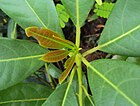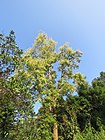Note: This is a project under development. The articles on this wiki are just being initiated and broadly incomplete. You can Help creating new pages.
Difference between revisions of "Persea macrantha"
| Line 1: | Line 1: | ||
[[File:Persea macrantha at Kannavam RF (2).jpg |thumb|right|'''Persea macrantha''']] | [[File:Persea macrantha at Kannavam RF (2).jpg |thumb|right|'''Persea macrantha''']] | ||
| − | '''Persea macrantha''', | + | '''Persea macrantha''', Large-flowered bay tree is a species of plant in the family Lauraceae. It is native to Western Ghats of India and Sri Lanka. The plant grows to about 30 m (98 ft). |
==Uses== | ==Uses== | ||
{{Uses|Asthma}}, {{Uses|Rheumatism}}, {{Uses|Anti-inflammatory}}, {{Uses|Anti-arthritic}}. | {{Uses|Asthma}}, {{Uses|Rheumatism}}, {{Uses|Anti-inflammatory}}, {{Uses|Anti-arthritic}}. | ||
Revision as of 13:55, 13 June 2020
Persea macrantha, Large-flowered bay tree is a species of plant in the family Lauraceae. It is native to Western Ghats of India and Sri Lanka. The plant grows to about 30 m (98 ft).
Contents
- 1 Uses
- 2 Parts Used
- 3 Chemical Composition
- 4 Common names
- 5 Properties
- 6 Habit
- 7 Identification
- 8 List of Ayurvedic medicine in which the herb is used
- 9 Where to get the saplings
- 10 Mode of Propagation
- 11 How to plant/cultivate
- 12 Commonly seen growing in areas
- 13 Photo Gallery
- 14 References
- 15 External Links
Uses
Asthma, Rheumatism, Anti-inflammatory, Anti-arthritic.
Parts Used
Chemical Composition
The plant possesses alkaloid, steroid, tannins, flavonoids, saponins, terpenoids, phenols and carboxylic acid18. [1]
Common names
| Language | Common name |
|---|---|
| Kannada | Chittu thandri, Gulamaavu, Gulimaavu |
| Hindi | |
| Malayalam | Kulamavu, Ooravu |
| Tamil | Iruli, Kolamavu, Kolarmavu |
| Telugu | Naara |
| Marathi | NA |
| Gujarathi | NA |
| Punjabi | NA |
| Kashmiri | NA |
| Sanskrit | |
| English | Large-Flowered Bay Tree |
Properties
Reference: Dravya - Substance, Rasa - Taste, Guna - Qualities, Veerya - Potency, Vipaka - Post-digesion effect, Karma - Pharmacological activity, Prabhava - Therepeutics.
Dravya
Rasa
Guna
Veerya
Vipaka
Karma
Prabhava
Habit
Identification
Leaf
| Kind | Shape | Feature |
|---|---|---|
| Simple, Alternate, Clustered at twig ends | Spiral in outline | Petiole 1.2-4.5 cm long, canaliculate, glabrous; lamina 7-20.3 x 3-8 cm long, variable in shape, obovate or elliptic to elliptic-oblong, apex rounded or acuminate or acute, base acute to rounded, margin entire, coriaceous, glabrous, glaucous beneath, aromatic when squeeze; midrib canaliculate above; secondary_nerves 8-12 pairs. |
Flower
| Type | Size | Color and composition | Stamen | More information |
|---|---|---|---|---|
| Bisexual | broadly ovate-heart-shaped | Pale yellow | 1.0-1.2 cm across, In panicles from upper axils and terminal. Flower tube is very short, tepals 6, nearly equal, in 2 series, 4-5 mm, obovate, puberulous |
Fruit
| Type | Size | Mass | Appearance | Seeds | More information |
|---|---|---|---|---|---|
| Simple Fruit | Berry is spherical | 2 cm across | Black | {{{6}}} |
Other features
List of Ayurvedic medicine in which the herb is used
Where to get the saplings
Mode of Propagation
How to plant/cultivate
Persea macrantha (Nees) Kosterm belongs to the family Lauraceae. It is a tree growing up to 30m in length and is mainly distributed in Western peninsula, Ceylon and India etc. In India, the plant is found in various states such as Karnataka, Bihar, Maharashtra and Assam up to an altitude of 2100m. [3]
Commonly seen growing in areas
Photo Gallery
References
External Links
- Ayurvedic Herbs known to be helpful to treat Asthma
- Ayurvedic Herbs known to be helpful to treat Rheumatism
- Ayurvedic Herbs known to be helpful to treat Anti-inflammatory
- Ayurvedic Herbs known to be helpful to treat Anti-arthritic
- Herbs with Leaves used in medicine
- Herbs with common name in Kannada
- Herbs with common name in Malayalam
- Herbs with common name in Tamil
- Herbs with common name in Telugu
- Herbs with common name in English
- Habit - Tree
- Index of Plants which can be propagated by Seeds
- Herbs that are commonly seen in the region of Tropical area
- Herbs
- Lauraceae




